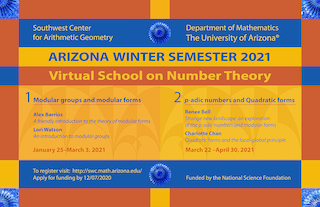
Arizona Winter Semester 2021: Virtual School in Number Theory
AWS 2021 will be held in two, 6-week, online sessions. Each session will feature two lecture series consisting of 6 lectures each (one per week), as well as accompanying problem sessions and moderated discussions. The intended audience is undergraduates, but we welcome all interested participants.
- Organizers: Alina Bucur, Bryden Cais, Kiran Kedlaya, and David Zureick-Brown (main program), with Mirela Ciperiani, Brandon Levin, and Hang Xue.
- Funded by the National Science Foundation, with additional support from CIMPA.
- Questions? Please contact swc-coordinator@math.arizona.edu.
To join the online Zulip discussion forum and connect with lecturers, assistants, and other participants, please fill out this form. You will receive further instructions from Zulip to the email you provide.
Session 1: January 25 — March 6, 2021
-
Alex Barrios: A friendly introduction to the theory of modular forms
In 1770, Lagrange proved that every natural number can be represented as a sum of four squares! For instance, 86=62+52+42+32. But it can also be written as 86=82+32+32+22. This led mathematicians to ask: Given a natural number n, how many different ways are there of writing n as a sum of four squares? In 1834, Jacobi found a formula that answered this question for every natural number! As part of this course, we will embark on proving Jacobi's formula and, in the process, venture into the realm of modular forms. By tracing their historical roots, we will unravel the mysteries that attracted mathematicians to the theory of modular forms long before their famed use in the proof of Fermat's Last Theorem.
- Video:
- Notes:
- Problem Sets:
-
Lori Watson: An introduction to modular groups
The study of elliptic curves constitutes one of the major areas of research in number theory today. Perhaps surprisingly, the group SL2(Z) (in particular its subgroups and its action on the complex upper half plane) helps inform our understanding of these curves. In this series, we will explore that connection by learning about modular groups (certain subgroups of SL2(Z)) and the modular curves they give rise to.
- Video:
- Notes:
- Problem Sets:
-
Assisted by
Yongyi Chen, Robert Dicks, Edna Jones, Razan Taha (Barrios), and Tyler Genao, Hyun Jong Kim Zonia Menendez, Sam Mundy (Watson)
Session 2: March 22 — May 1, 2021
-
Renee Bell: Strange new landscape: an exploration of the p-adic numbers and modular forms
In this series, we will introduce a different notion of distance between rational numbers which encodes information about a prime. This will lead us to define the field of p-adic numbers, which are analogous to the real numbers but with exotic new topological features (for example, every open ball is closed and every point in a disk is a center of the disk). This gives us a new lens through which to view congruences of integers, and allows us to use tools from analysis and calculus to approach number-theoretic problems, like looking for integer solutions to equations. After building up this theory, we explore an analogue of classical modular forms over the p-adic numbers which links congruency of modular forms to the p-adic topology, and discuss the Galois representations associated to modular forms and their relation to Fermat's Last Theorem.
- Video:
- Notes:
- Problem Sets:
-
Charlotte Chan: Quadratic forms and the local global-principle
Can you write any positive integer as the sum of two squares? (No—3 can't be.) What about the sum of three squares? (No—7 can't be.) Remarkably, these questions can be answered through the study of quadratic forms. Central to our exploration will be the local-global principle, a pervasive theme in modern number theory that encapsulates the idea that there should be a dictionary between rational phenomena (Q) and p-adic phenomena (Qp).
- Video:
- Notes:
- Problem Sets:
-
Assisted by
Jon Aycock, Qiao He, Jonathan Love, Hanneke Wiersema (Bell), and Elisa Bellah, Sheela Devadas, Alex Horawa, Maryam Khaqan (Chan)